Management vs. Leadership: Styles and Organizational Challenges
VerifiedAdded on 2020/04/07
|9
|1947
|72
Essay
AI Summary
This essay delves into the critical distinctions between leadership and management, arguing that the structured role of a leader often diminishes into mere management, particularly when control and command approaches are prioritized over leadership qualities. It contrasts the managerial focus on control and adherence to procedures with leadership's emphasis on guiding an organization towards goals, seeking input, and fostering employee development. The essay explores four management styles and examines the challenges of over-managed organizations, where rigid adherence to rules stifles initiative and innovation. It discusses the Path-Goal Theory and the importance of directive, supportive, participative, and achievement-oriented leadership styles. The essay further reviews articles that highlight the need for a paradigm shift from management to leadership, emphasizing the importance of interpersonal skills, ethical conduct, and employee empowerment. The conclusion underscores the necessity of adapting management styles to embrace leadership principles for success in the competitive business environment, highlighting the value of employee support and engagement.
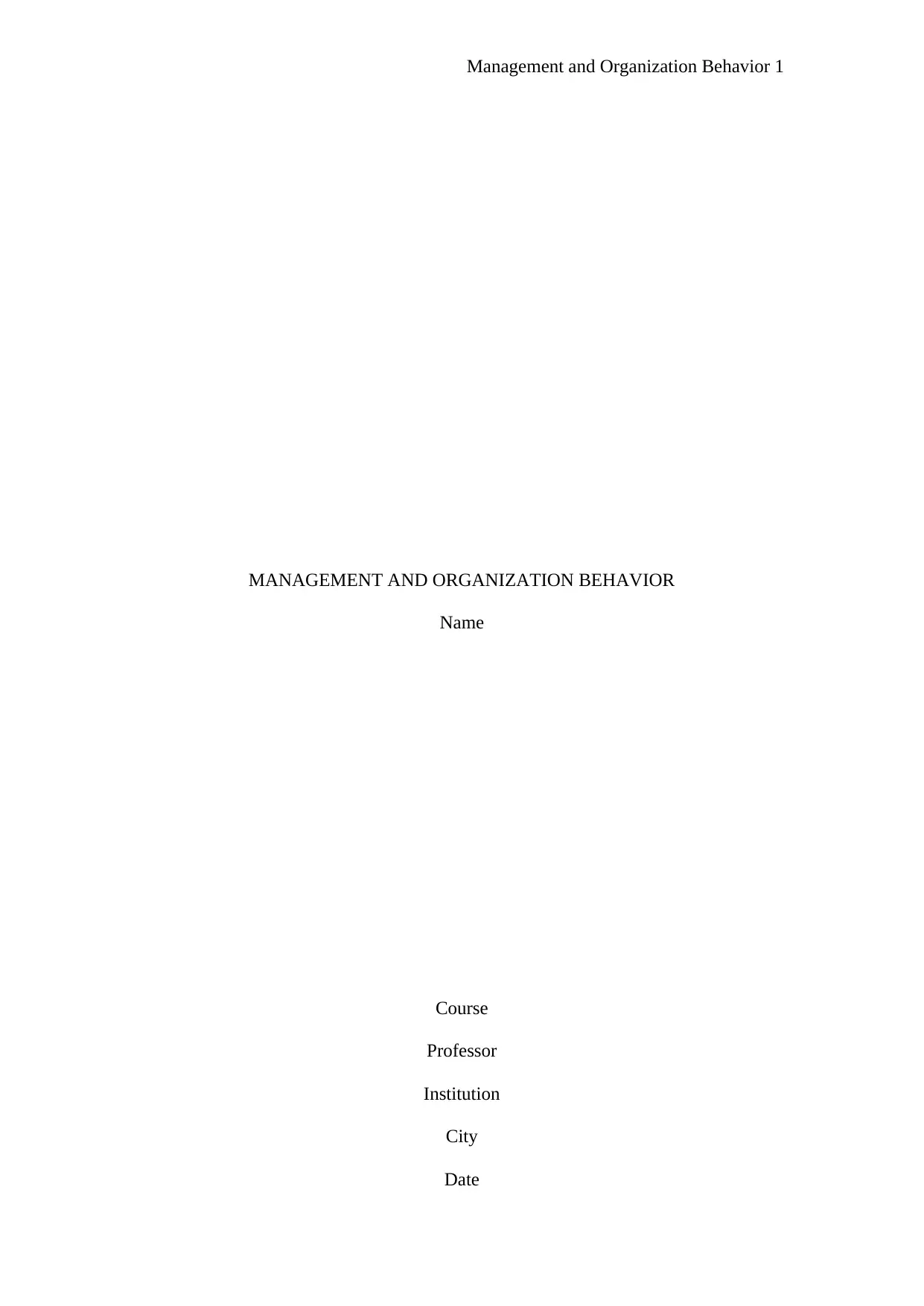
Management and Organization Behavior 1
MANAGEMENT AND ORGANIZATION BEHAVIOR
Name
Course
Professor
Institution
City
Date
MANAGEMENT AND ORGANIZATION BEHAVIOR
Name
Course
Professor
Institution
City
Date
Paraphrase This Document
Need a fresh take? Get an instant paraphrase of this document with our AI Paraphraser
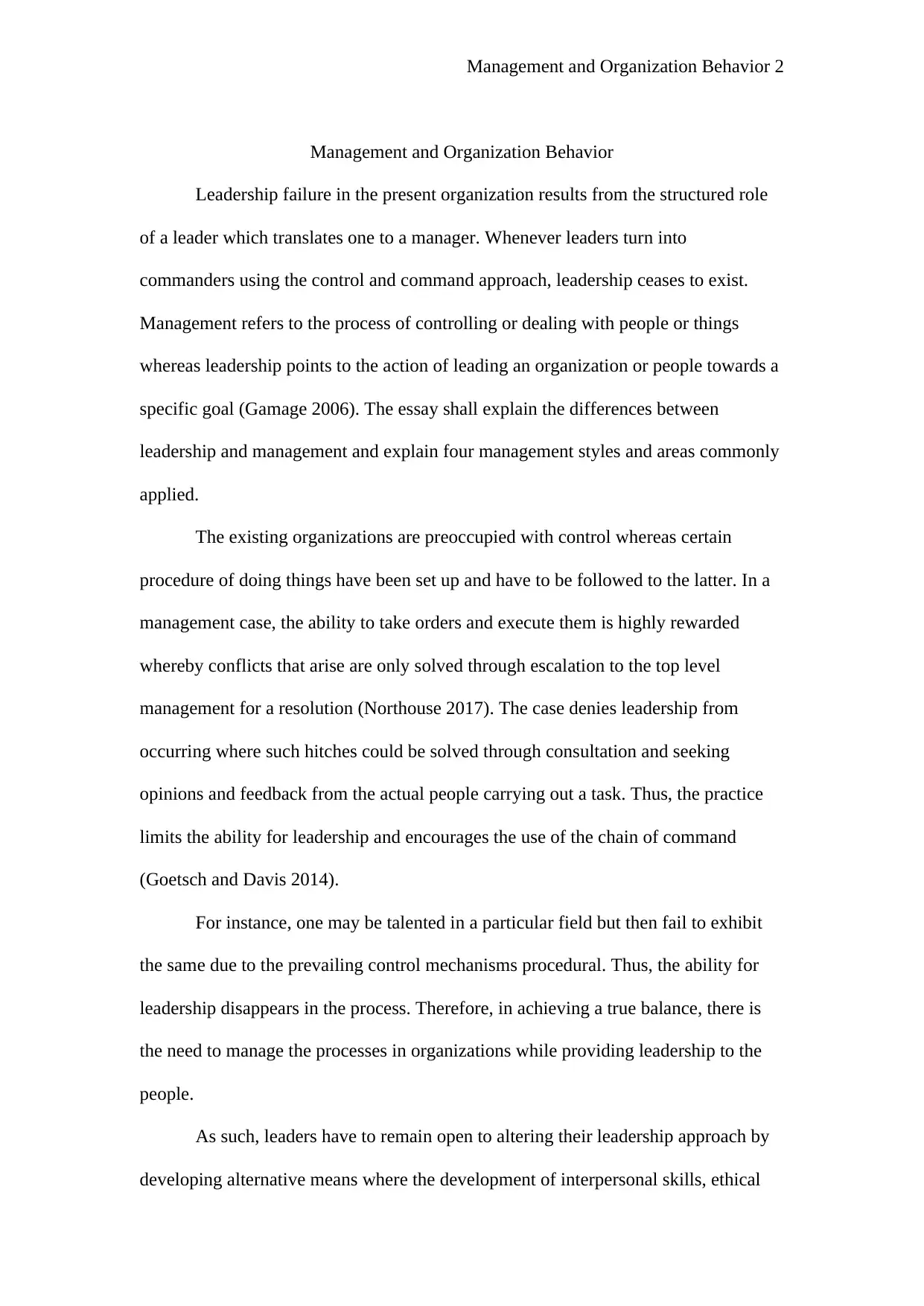
Management and Organization Behavior 2
Management and Organization Behavior
Leadership failure in the present organization results from the structured role
of a leader which translates one to a manager. Whenever leaders turn into
commanders using the control and command approach, leadership ceases to exist.
Management refers to the process of controlling or dealing with people or things
whereas leadership points to the action of leading an organization or people towards a
specific goal (Gamage 2006). The essay shall explain the differences between
leadership and management and explain four management styles and areas commonly
applied.
The existing organizations are preoccupied with control whereas certain
procedure of doing things have been set up and have to be followed to the latter. In a
management case, the ability to take orders and execute them is highly rewarded
whereby conflicts that arise are only solved through escalation to the top level
management for a resolution (Northouse 2017). The case denies leadership from
occurring where such hitches could be solved through consultation and seeking
opinions and feedback from the actual people carrying out a task. Thus, the practice
limits the ability for leadership and encourages the use of the chain of command
(Goetsch and Davis 2014).
For instance, one may be talented in a particular field but then fail to exhibit
the same due to the prevailing control mechanisms procedural. Thus, the ability for
leadership disappears in the process. Therefore, in achieving a true balance, there is
the need to manage the processes in organizations while providing leadership to the
people.
As such, leaders have to remain open to altering their leadership approach by
developing alternative means where the development of interpersonal skills, ethical
Management and Organization Behavior
Leadership failure in the present organization results from the structured role
of a leader which translates one to a manager. Whenever leaders turn into
commanders using the control and command approach, leadership ceases to exist.
Management refers to the process of controlling or dealing with people or things
whereas leadership points to the action of leading an organization or people towards a
specific goal (Gamage 2006). The essay shall explain the differences between
leadership and management and explain four management styles and areas commonly
applied.
The existing organizations are preoccupied with control whereas certain
procedure of doing things have been set up and have to be followed to the latter. In a
management case, the ability to take orders and execute them is highly rewarded
whereby conflicts that arise are only solved through escalation to the top level
management for a resolution (Northouse 2017). The case denies leadership from
occurring where such hitches could be solved through consultation and seeking
opinions and feedback from the actual people carrying out a task. Thus, the practice
limits the ability for leadership and encourages the use of the chain of command
(Goetsch and Davis 2014).
For instance, one may be talented in a particular field but then fail to exhibit
the same due to the prevailing control mechanisms procedural. Thus, the ability for
leadership disappears in the process. Therefore, in achieving a true balance, there is
the need to manage the processes in organizations while providing leadership to the
people.
As such, leaders have to remain open to altering their leadership approach by
developing alternative means where the development of interpersonal skills, ethical
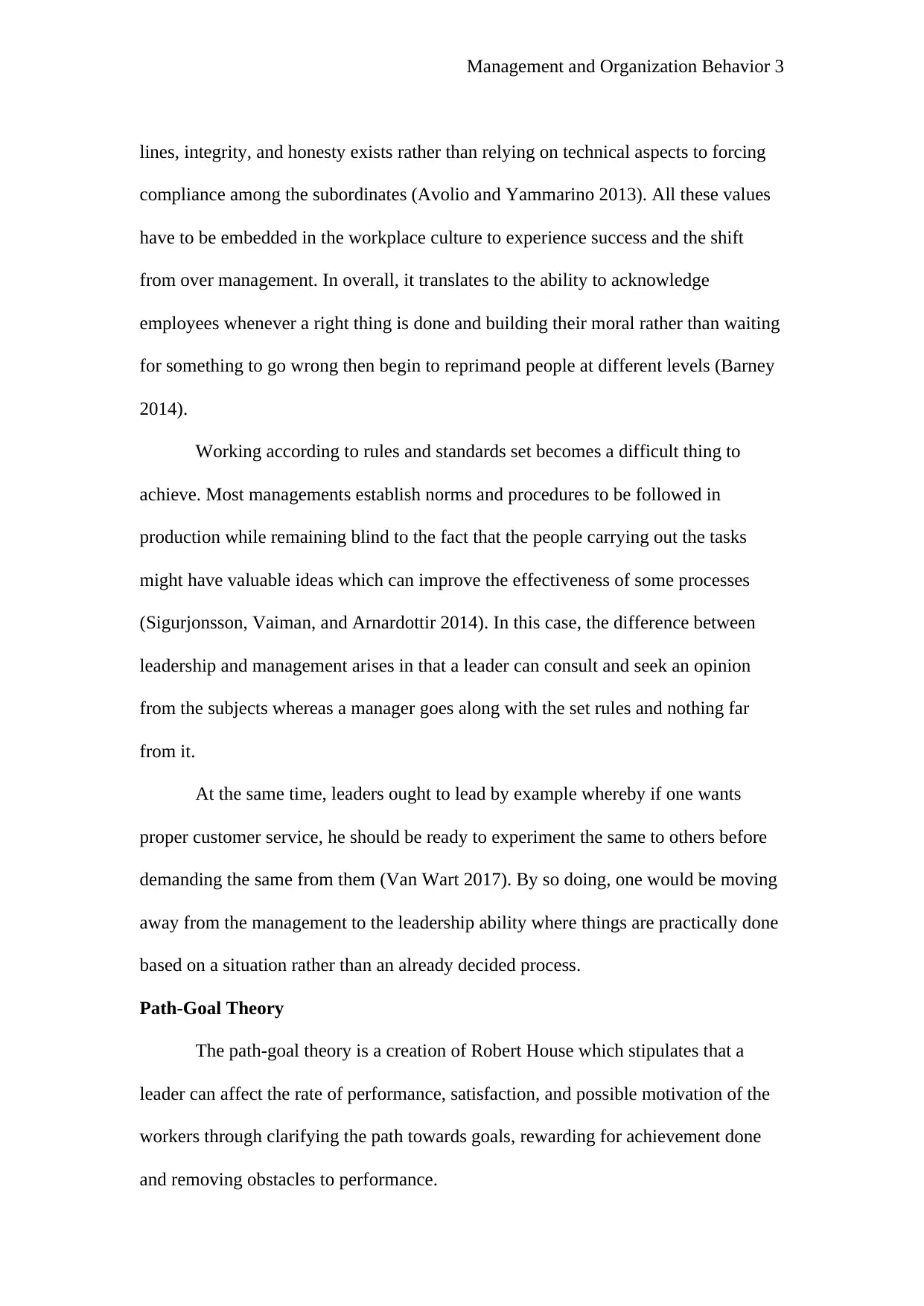
Management and Organization Behavior 3
lines, integrity, and honesty exists rather than relying on technical aspects to forcing
compliance among the subordinates (Avolio and Yammarino 2013). All these values
have to be embedded in the workplace culture to experience success and the shift
from over management. In overall, it translates to the ability to acknowledge
employees whenever a right thing is done and building their moral rather than waiting
for something to go wrong then begin to reprimand people at different levels (Barney
2014).
Working according to rules and standards set becomes a difficult thing to
achieve. Most managements establish norms and procedures to be followed in
production while remaining blind to the fact that the people carrying out the tasks
might have valuable ideas which can improve the effectiveness of some processes
(Sigurjonsson, Vaiman, and Arnardottir 2014). In this case, the difference between
leadership and management arises in that a leader can consult and seek an opinion
from the subjects whereas a manager goes along with the set rules and nothing far
from it.
At the same time, leaders ought to lead by example whereby if one wants
proper customer service, he should be ready to experiment the same to others before
demanding the same from them (Van Wart 2017). By so doing, one would be moving
away from the management to the leadership ability where things are practically done
based on a situation rather than an already decided process.
Path-Goal Theory
The path-goal theory is a creation of Robert House which stipulates that a
leader can affect the rate of performance, satisfaction, and possible motivation of the
workers through clarifying the path towards goals, rewarding for achievement done
and removing obstacles to performance.
lines, integrity, and honesty exists rather than relying on technical aspects to forcing
compliance among the subordinates (Avolio and Yammarino 2013). All these values
have to be embedded in the workplace culture to experience success and the shift
from over management. In overall, it translates to the ability to acknowledge
employees whenever a right thing is done and building their moral rather than waiting
for something to go wrong then begin to reprimand people at different levels (Barney
2014).
Working according to rules and standards set becomes a difficult thing to
achieve. Most managements establish norms and procedures to be followed in
production while remaining blind to the fact that the people carrying out the tasks
might have valuable ideas which can improve the effectiveness of some processes
(Sigurjonsson, Vaiman, and Arnardottir 2014). In this case, the difference between
leadership and management arises in that a leader can consult and seek an opinion
from the subjects whereas a manager goes along with the set rules and nothing far
from it.
At the same time, leaders ought to lead by example whereby if one wants
proper customer service, he should be ready to experiment the same to others before
demanding the same from them (Van Wart 2017). By so doing, one would be moving
away from the management to the leadership ability where things are practically done
based on a situation rather than an already decided process.
Path-Goal Theory
The path-goal theory is a creation of Robert House which stipulates that a
leader can affect the rate of performance, satisfaction, and possible motivation of the
workers through clarifying the path towards goals, rewarding for achievement done
and removing obstacles to performance.
⊘ This is a preview!⊘
Do you want full access?
Subscribe today to unlock all pages.

Trusted by 1+ million students worldwide
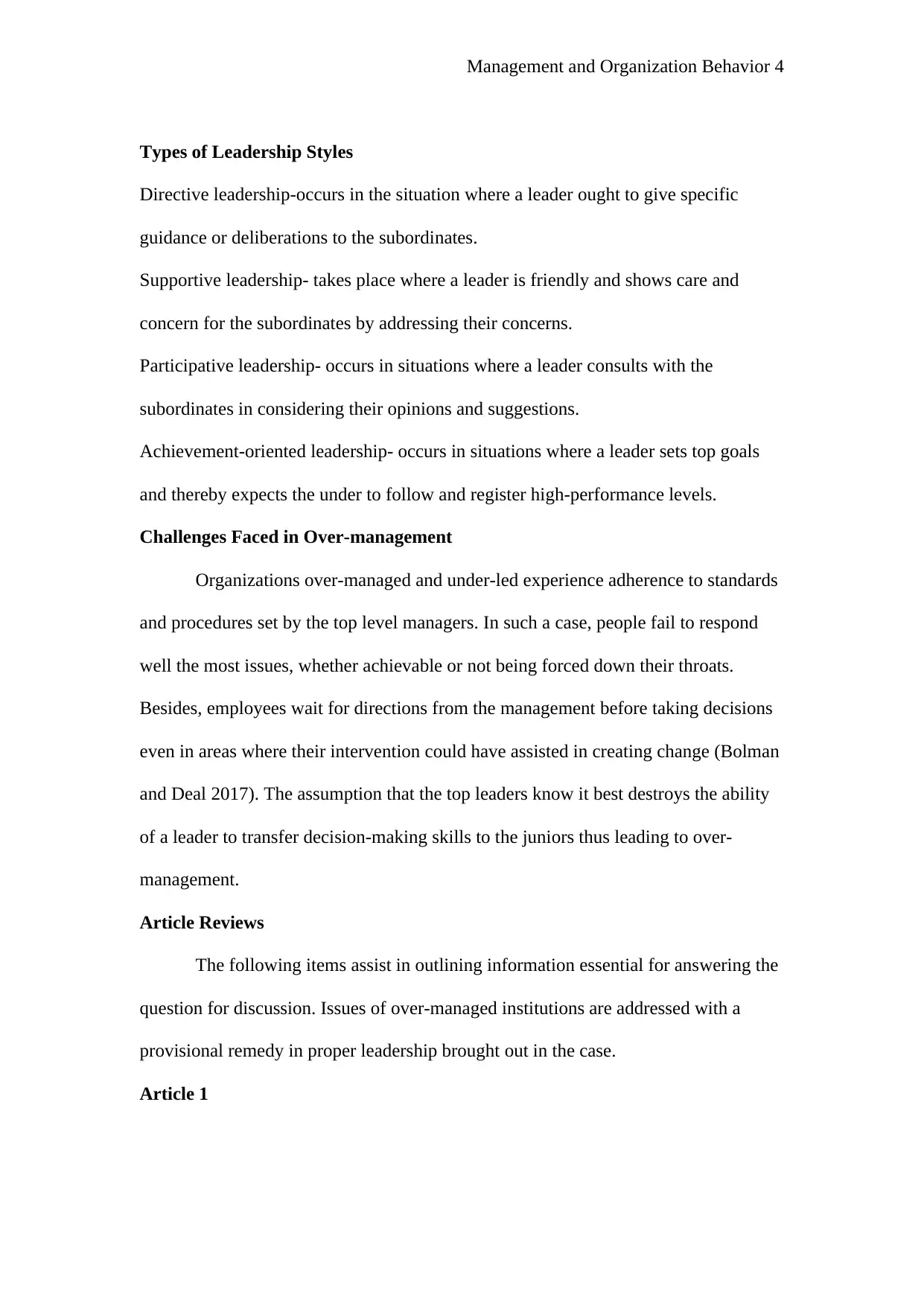
Management and Organization Behavior 4
Types of Leadership Styles
Directive leadership-occurs in the situation where a leader ought to give specific
guidance or deliberations to the subordinates.
Supportive leadership- takes place where a leader is friendly and shows care and
concern for the subordinates by addressing their concerns.
Participative leadership- occurs in situations where a leader consults with the
subordinates in considering their opinions and suggestions.
Achievement-oriented leadership- occurs in situations where a leader sets top goals
and thereby expects the under to follow and register high-performance levels.
Challenges Faced in Over-management
Organizations over-managed and under-led experience adherence to standards
and procedures set by the top level managers. In such a case, people fail to respond
well the most issues, whether achievable or not being forced down their throats.
Besides, employees wait for directions from the management before taking decisions
even in areas where their intervention could have assisted in creating change (Bolman
and Deal 2017). The assumption that the top leaders know it best destroys the ability
of a leader to transfer decision-making skills to the juniors thus leading to over-
management.
Article Reviews
The following items assist in outlining information essential for answering the
question for discussion. Issues of over-managed institutions are addressed with a
provisional remedy in proper leadership brought out in the case.
Article 1
Types of Leadership Styles
Directive leadership-occurs in the situation where a leader ought to give specific
guidance or deliberations to the subordinates.
Supportive leadership- takes place where a leader is friendly and shows care and
concern for the subordinates by addressing their concerns.
Participative leadership- occurs in situations where a leader consults with the
subordinates in considering their opinions and suggestions.
Achievement-oriented leadership- occurs in situations where a leader sets top goals
and thereby expects the under to follow and register high-performance levels.
Challenges Faced in Over-management
Organizations over-managed and under-led experience adherence to standards
and procedures set by the top level managers. In such a case, people fail to respond
well the most issues, whether achievable or not being forced down their throats.
Besides, employees wait for directions from the management before taking decisions
even in areas where their intervention could have assisted in creating change (Bolman
and Deal 2017). The assumption that the top leaders know it best destroys the ability
of a leader to transfer decision-making skills to the juniors thus leading to over-
management.
Article Reviews
The following items assist in outlining information essential for answering the
question for discussion. Issues of over-managed institutions are addressed with a
provisional remedy in proper leadership brought out in the case.
Article 1
Paraphrase This Document
Need a fresh take? Get an instant paraphrase of this document with our AI Paraphraser
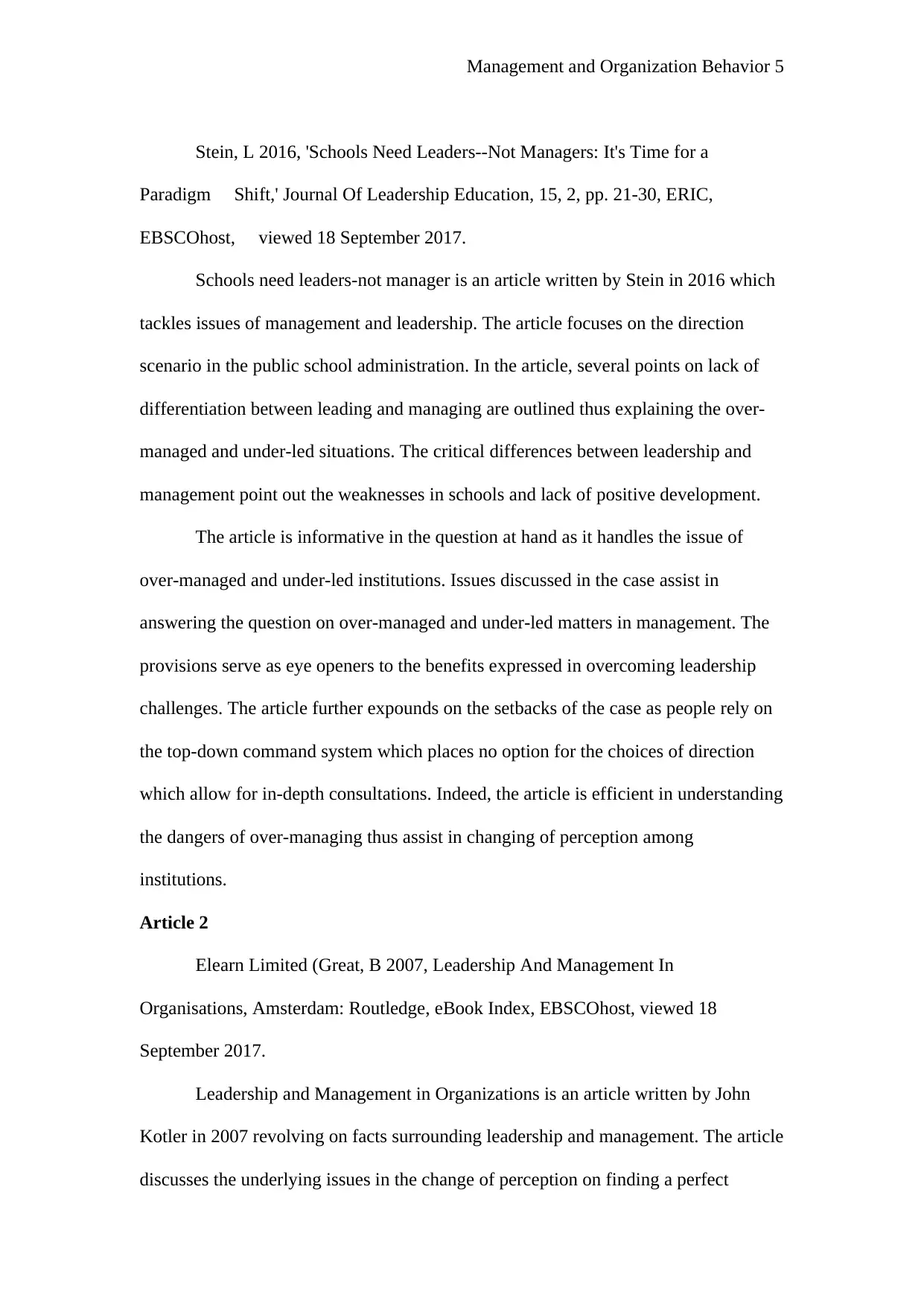
Management and Organization Behavior 5
Stein, L 2016, 'Schools Need Leaders--Not Managers: It's Time for a
Paradigm Shift,' Journal Of Leadership Education, 15, 2, pp. 21-30, ERIC,
EBSCOhost, viewed 18 September 2017.
Schools need leaders-not manager is an article written by Stein in 2016 which
tackles issues of management and leadership. The article focuses on the direction
scenario in the public school administration. In the article, several points on lack of
differentiation between leading and managing are outlined thus explaining the over-
managed and under-led situations. The critical differences between leadership and
management point out the weaknesses in schools and lack of positive development.
The article is informative in the question at hand as it handles the issue of
over-managed and under-led institutions. Issues discussed in the case assist in
answering the question on over-managed and under-led matters in management. The
provisions serve as eye openers to the benefits expressed in overcoming leadership
challenges. The article further expounds on the setbacks of the case as people rely on
the top-down command system which places no option for the choices of direction
which allow for in-depth consultations. Indeed, the article is efficient in understanding
the dangers of over-managing thus assist in changing of perception among
institutions.
Article 2
Elearn Limited (Great, B 2007, Leadership And Management In
Organisations, Amsterdam: Routledge, eBook Index, EBSCOhost, viewed 18
September 2017.
Leadership and Management in Organizations is an article written by John
Kotler in 2007 revolving on facts surrounding leadership and management. The article
discusses the underlying issues in the change of perception on finding a perfect
Stein, L 2016, 'Schools Need Leaders--Not Managers: It's Time for a
Paradigm Shift,' Journal Of Leadership Education, 15, 2, pp. 21-30, ERIC,
EBSCOhost, viewed 18 September 2017.
Schools need leaders-not manager is an article written by Stein in 2016 which
tackles issues of management and leadership. The article focuses on the direction
scenario in the public school administration. In the article, several points on lack of
differentiation between leading and managing are outlined thus explaining the over-
managed and under-led situations. The critical differences between leadership and
management point out the weaknesses in schools and lack of positive development.
The article is informative in the question at hand as it handles the issue of
over-managed and under-led institutions. Issues discussed in the case assist in
answering the question on over-managed and under-led matters in management. The
provisions serve as eye openers to the benefits expressed in overcoming leadership
challenges. The article further expounds on the setbacks of the case as people rely on
the top-down command system which places no option for the choices of direction
which allow for in-depth consultations. Indeed, the article is efficient in understanding
the dangers of over-managing thus assist in changing of perception among
institutions.
Article 2
Elearn Limited (Great, B 2007, Leadership And Management In
Organisations, Amsterdam: Routledge, eBook Index, EBSCOhost, viewed 18
September 2017.
Leadership and Management in Organizations is an article written by John
Kotler in 2007 revolving on facts surrounding leadership and management. The article
discusses the underlying issues in the change of perception on finding a perfect
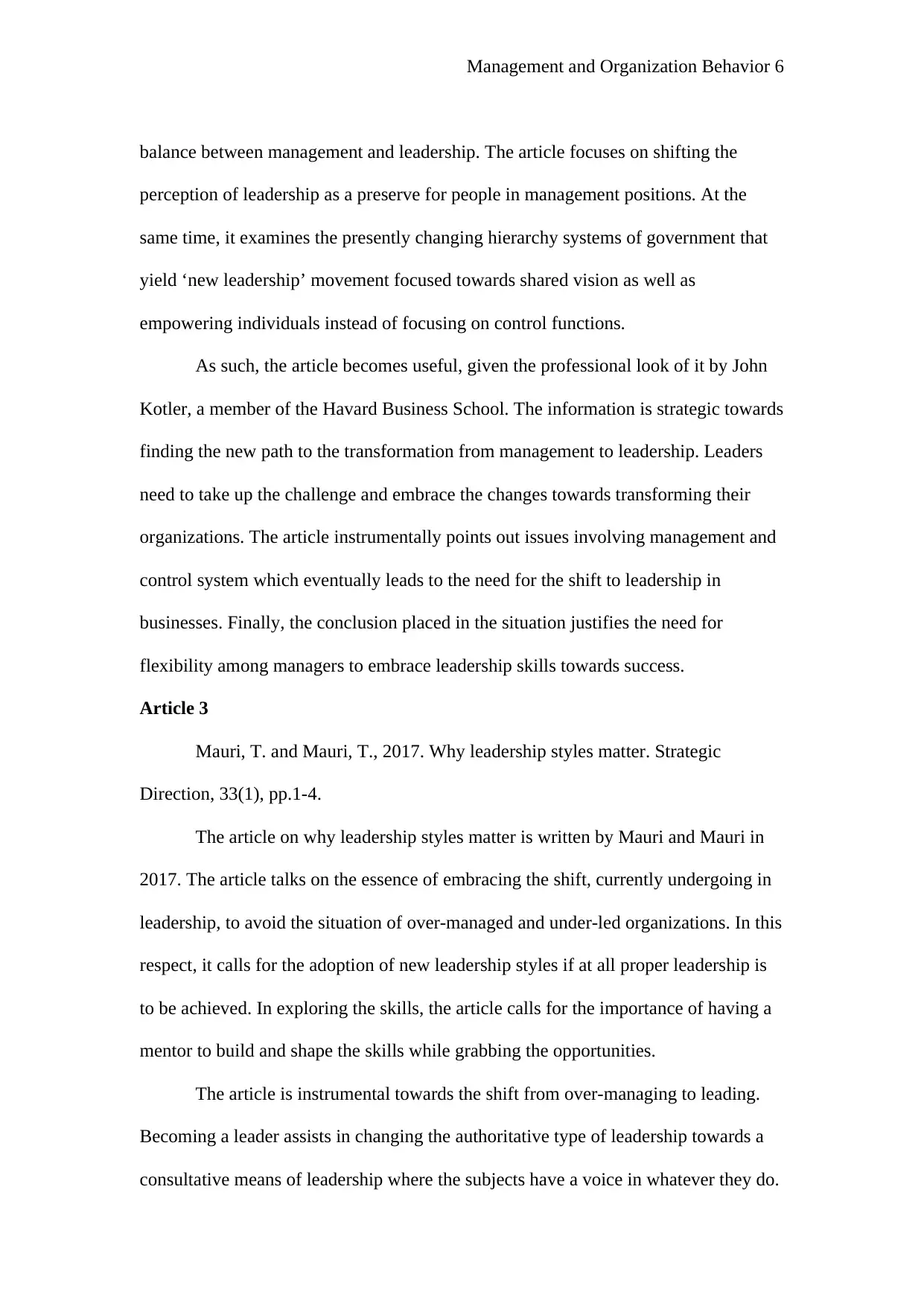
Management and Organization Behavior 6
balance between management and leadership. The article focuses on shifting the
perception of leadership as a preserve for people in management positions. At the
same time, it examines the presently changing hierarchy systems of government that
yield ‘new leadership’ movement focused towards shared vision as well as
empowering individuals instead of focusing on control functions.
As such, the article becomes useful, given the professional look of it by John
Kotler, a member of the Havard Business School. The information is strategic towards
finding the new path to the transformation from management to leadership. Leaders
need to take up the challenge and embrace the changes towards transforming their
organizations. The article instrumentally points out issues involving management and
control system which eventually leads to the need for the shift to leadership in
businesses. Finally, the conclusion placed in the situation justifies the need for
flexibility among managers to embrace leadership skills towards success.
Article 3
Mauri, T. and Mauri, T., 2017. Why leadership styles matter. Strategic
Direction, 33(1), pp.1-4.
The article on why leadership styles matter is written by Mauri and Mauri in
2017. The article talks on the essence of embracing the shift, currently undergoing in
leadership, to avoid the situation of over-managed and under-led organizations. In this
respect, it calls for the adoption of new leadership styles if at all proper leadership is
to be achieved. In exploring the skills, the article calls for the importance of having a
mentor to build and shape the skills while grabbing the opportunities.
The article is instrumental towards the shift from over-managing to leading.
Becoming a leader assists in changing the authoritative type of leadership towards a
consultative means of leadership where the subjects have a voice in whatever they do.
balance between management and leadership. The article focuses on shifting the
perception of leadership as a preserve for people in management positions. At the
same time, it examines the presently changing hierarchy systems of government that
yield ‘new leadership’ movement focused towards shared vision as well as
empowering individuals instead of focusing on control functions.
As such, the article becomes useful, given the professional look of it by John
Kotler, a member of the Havard Business School. The information is strategic towards
finding the new path to the transformation from management to leadership. Leaders
need to take up the challenge and embrace the changes towards transforming their
organizations. The article instrumentally points out issues involving management and
control system which eventually leads to the need for the shift to leadership in
businesses. Finally, the conclusion placed in the situation justifies the need for
flexibility among managers to embrace leadership skills towards success.
Article 3
Mauri, T. and Mauri, T., 2017. Why leadership styles matter. Strategic
Direction, 33(1), pp.1-4.
The article on why leadership styles matter is written by Mauri and Mauri in
2017. The article talks on the essence of embracing the shift, currently undergoing in
leadership, to avoid the situation of over-managed and under-led organizations. In this
respect, it calls for the adoption of new leadership styles if at all proper leadership is
to be achieved. In exploring the skills, the article calls for the importance of having a
mentor to build and shape the skills while grabbing the opportunities.
The article is instrumental towards the shift from over-managing to leading.
Becoming a leader assists in changing the authoritative type of leadership towards a
consultative means of leadership where the subjects have a voice in whatever they do.
⊘ This is a preview!⊘
Do you want full access?
Subscribe today to unlock all pages.

Trusted by 1+ million students worldwide
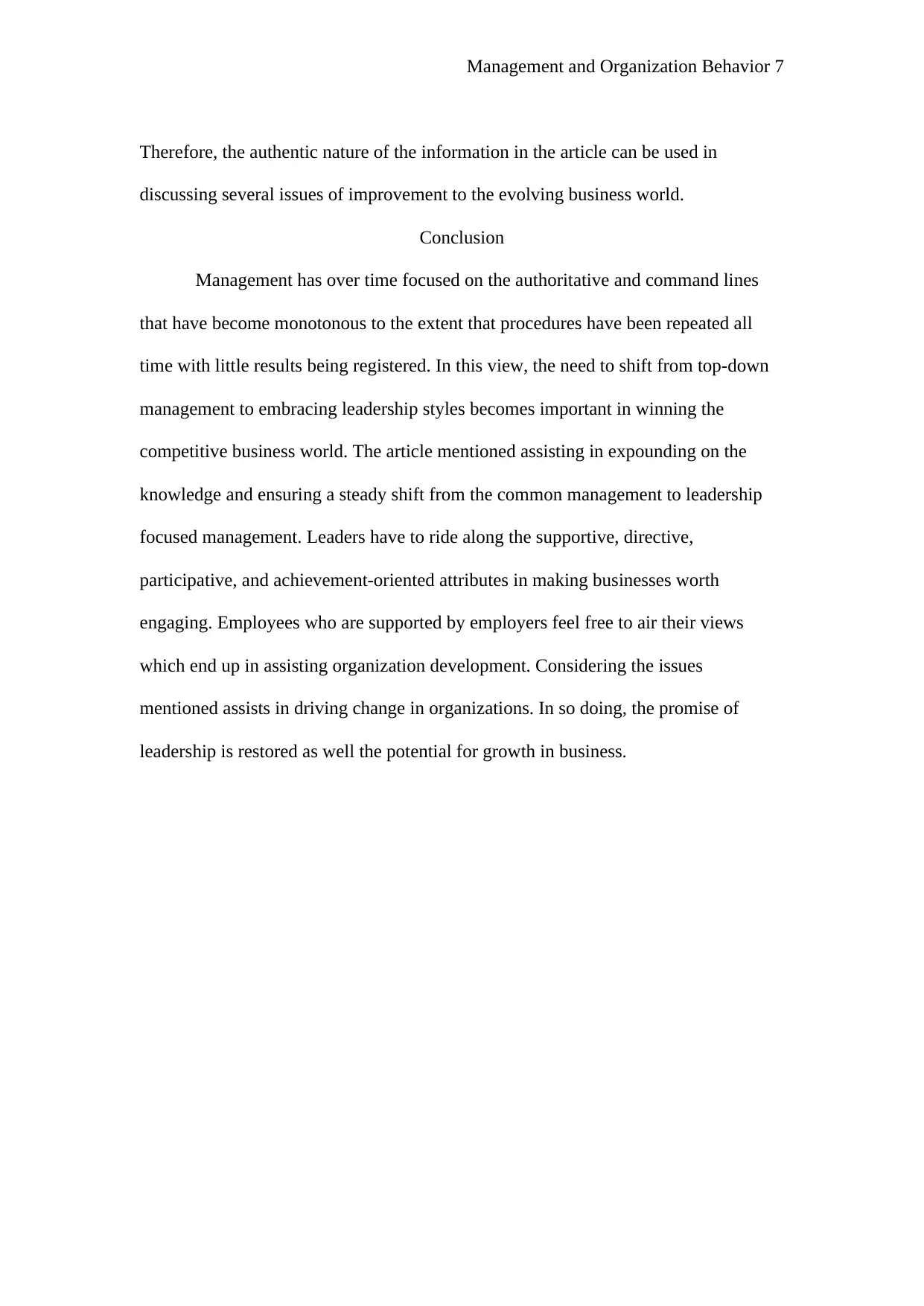
Management and Organization Behavior 7
Therefore, the authentic nature of the information in the article can be used in
discussing several issues of improvement to the evolving business world.
Conclusion
Management has over time focused on the authoritative and command lines
that have become monotonous to the extent that procedures have been repeated all
time with little results being registered. In this view, the need to shift from top-down
management to embracing leadership styles becomes important in winning the
competitive business world. The article mentioned assisting in expounding on the
knowledge and ensuring a steady shift from the common management to leadership
focused management. Leaders have to ride along the supportive, directive,
participative, and achievement-oriented attributes in making businesses worth
engaging. Employees who are supported by employers feel free to air their views
which end up in assisting organization development. Considering the issues
mentioned assists in driving change in organizations. In so doing, the promise of
leadership is restored as well the potential for growth in business.
Therefore, the authentic nature of the information in the article can be used in
discussing several issues of improvement to the evolving business world.
Conclusion
Management has over time focused on the authoritative and command lines
that have become monotonous to the extent that procedures have been repeated all
time with little results being registered. In this view, the need to shift from top-down
management to embracing leadership styles becomes important in winning the
competitive business world. The article mentioned assisting in expounding on the
knowledge and ensuring a steady shift from the common management to leadership
focused management. Leaders have to ride along the supportive, directive,
participative, and achievement-oriented attributes in making businesses worth
engaging. Employees who are supported by employers feel free to air their views
which end up in assisting organization development. Considering the issues
mentioned assists in driving change in organizations. In so doing, the promise of
leadership is restored as well the potential for growth in business.
Paraphrase This Document
Need a fresh take? Get an instant paraphrase of this document with our AI Paraphraser
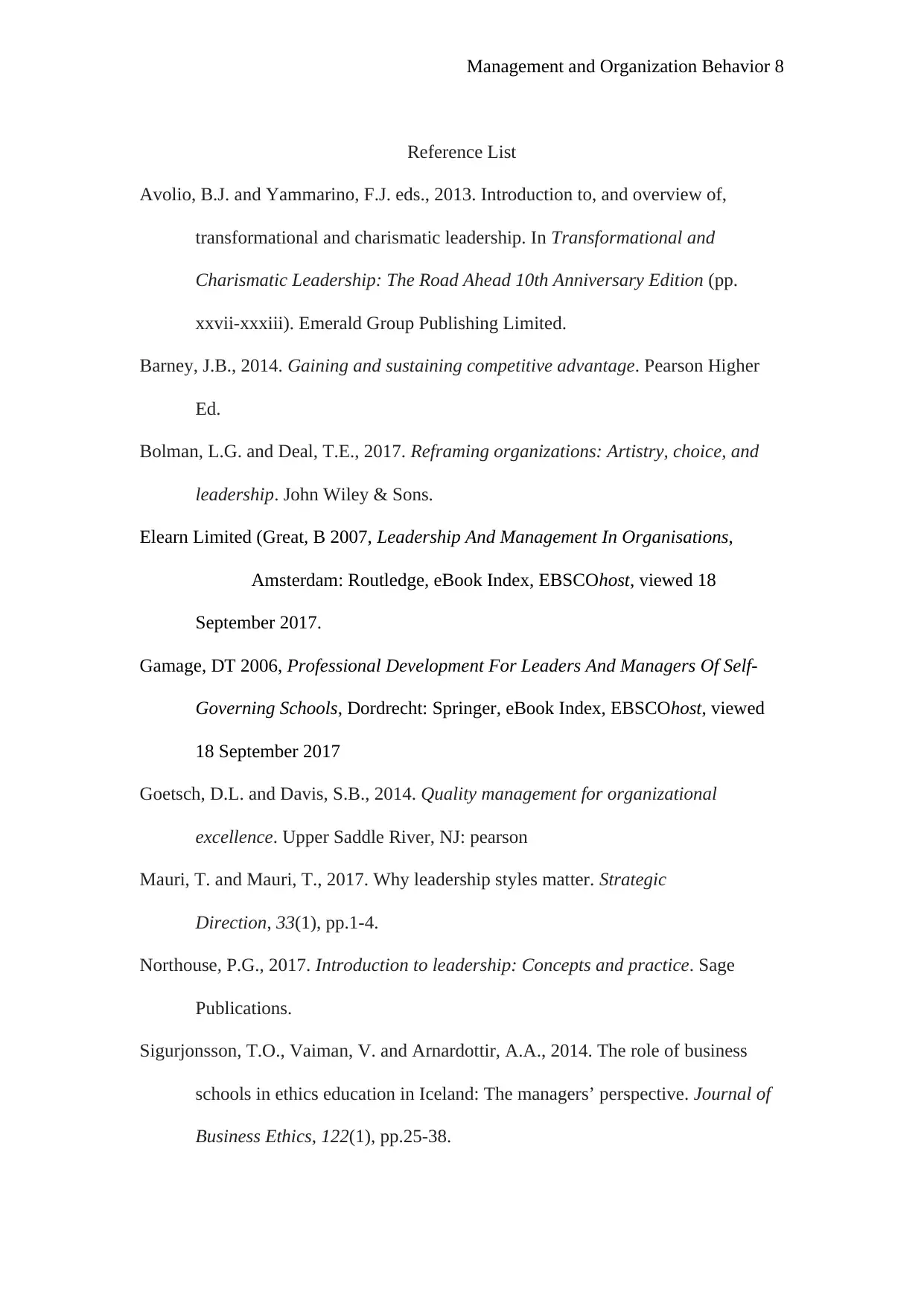
Management and Organization Behavior 8
Reference List
Avolio, B.J. and Yammarino, F.J. eds., 2013. Introduction to, and overview of,
transformational and charismatic leadership. In Transformational and
Charismatic Leadership: The Road Ahead 10th Anniversary Edition (pp.
xxvii-xxxiii). Emerald Group Publishing Limited.
Barney, J.B., 2014. Gaining and sustaining competitive advantage. Pearson Higher
Ed.
Bolman, L.G. and Deal, T.E., 2017. Reframing organizations: Artistry, choice, and
leadership. John Wiley & Sons.
Elearn Limited (Great, B 2007, Leadership And Management In Organisations,
Amsterdam: Routledge, eBook Index, EBSCOhost, viewed 18
September 2017.
Gamage, DT 2006, Professional Development For Leaders And Managers Of Self-
Governing Schools, Dordrecht: Springer, eBook Index, EBSCOhost, viewed
18 September 2017
Goetsch, D.L. and Davis, S.B., 2014. Quality management for organizational
excellence. Upper Saddle River, NJ: pearson
Mauri, T. and Mauri, T., 2017. Why leadership styles matter. Strategic
Direction, 33(1), pp.1-4.
Northouse, P.G., 2017. Introduction to leadership: Concepts and practice. Sage
Publications.
Sigurjonsson, T.O., Vaiman, V. and Arnardottir, A.A., 2014. The role of business
schools in ethics education in Iceland: The managers’ perspective. Journal of
Business Ethics, 122(1), pp.25-38.
Reference List
Avolio, B.J. and Yammarino, F.J. eds., 2013. Introduction to, and overview of,
transformational and charismatic leadership. In Transformational and
Charismatic Leadership: The Road Ahead 10th Anniversary Edition (pp.
xxvii-xxxiii). Emerald Group Publishing Limited.
Barney, J.B., 2014. Gaining and sustaining competitive advantage. Pearson Higher
Ed.
Bolman, L.G. and Deal, T.E., 2017. Reframing organizations: Artistry, choice, and
leadership. John Wiley & Sons.
Elearn Limited (Great, B 2007, Leadership And Management In Organisations,
Amsterdam: Routledge, eBook Index, EBSCOhost, viewed 18
September 2017.
Gamage, DT 2006, Professional Development For Leaders And Managers Of Self-
Governing Schools, Dordrecht: Springer, eBook Index, EBSCOhost, viewed
18 September 2017
Goetsch, D.L. and Davis, S.B., 2014. Quality management for organizational
excellence. Upper Saddle River, NJ: pearson
Mauri, T. and Mauri, T., 2017. Why leadership styles matter. Strategic
Direction, 33(1), pp.1-4.
Northouse, P.G., 2017. Introduction to leadership: Concepts and practice. Sage
Publications.
Sigurjonsson, T.O., Vaiman, V. and Arnardottir, A.A., 2014. The role of business
schools in ethics education in Iceland: The managers’ perspective. Journal of
Business Ethics, 122(1), pp.25-38.
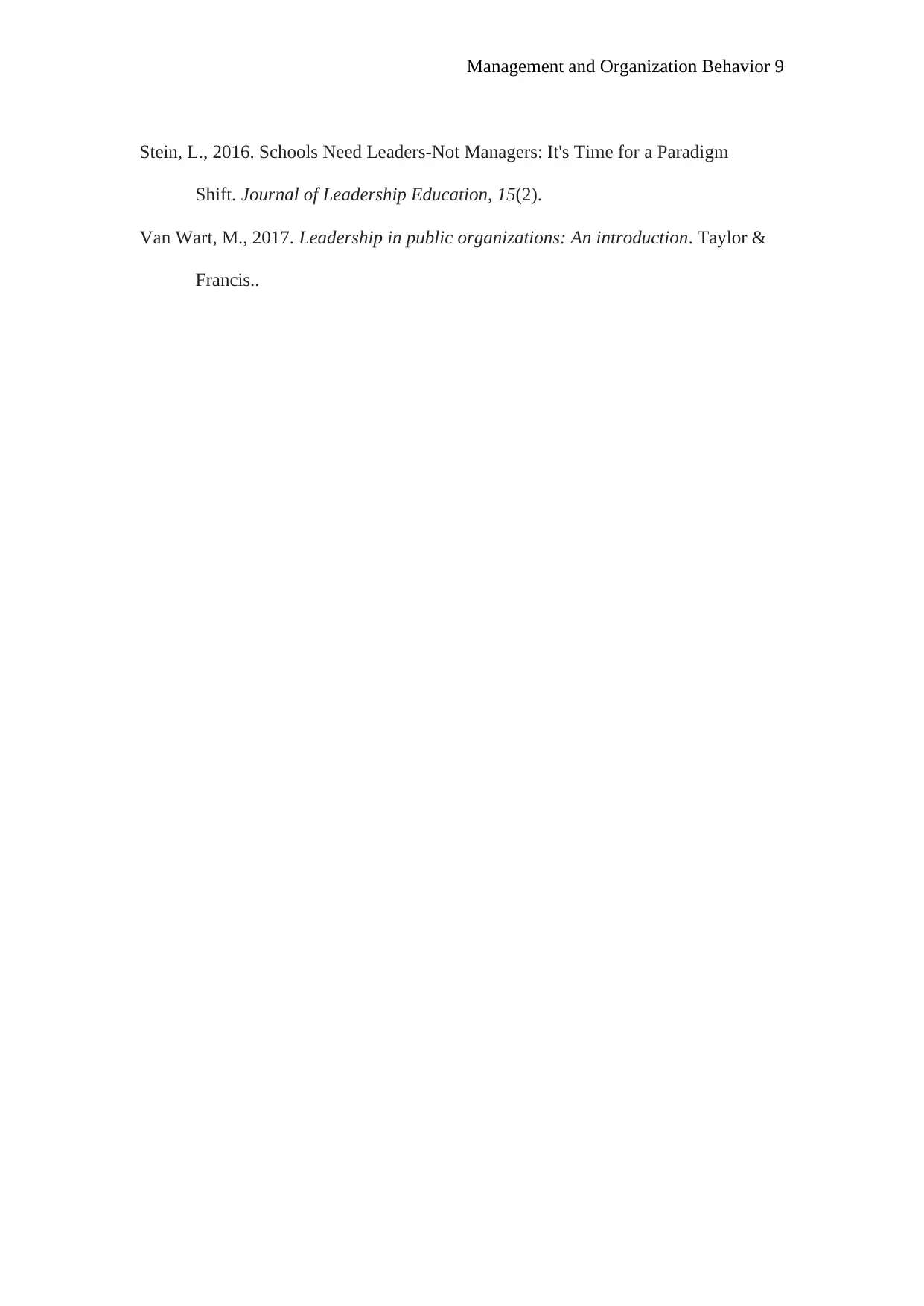
Management and Organization Behavior 9
Stein, L., 2016. Schools Need Leaders-Not Managers: It's Time for a Paradigm
Shift. Journal of Leadership Education, 15(2).
Van Wart, M., 2017. Leadership in public organizations: An introduction. Taylor &
Francis..
Stein, L., 2016. Schools Need Leaders-Not Managers: It's Time for a Paradigm
Shift. Journal of Leadership Education, 15(2).
Van Wart, M., 2017. Leadership in public organizations: An introduction. Taylor &
Francis..
⊘ This is a preview!⊘
Do you want full access?
Subscribe today to unlock all pages.

Trusted by 1+ million students worldwide
1 out of 9
Related Documents
Your All-in-One AI-Powered Toolkit for Academic Success.
+13062052269
info@desklib.com
Available 24*7 on WhatsApp / Email
![[object Object]](/_next/static/media/star-bottom.7253800d.svg)
Unlock your academic potential
Copyright © 2020–2025 A2Z Services. All Rights Reserved. Developed and managed by ZUCOL.





